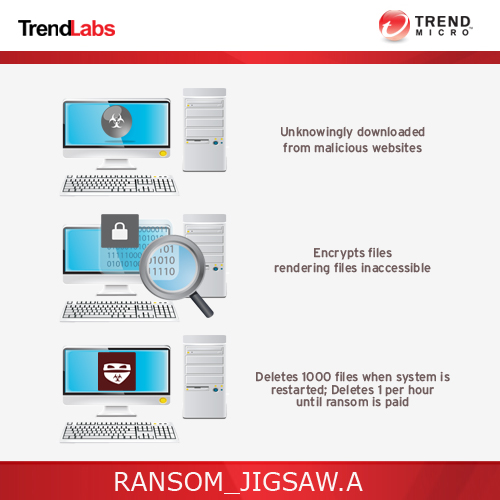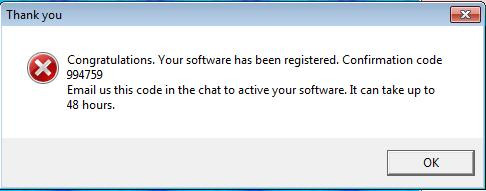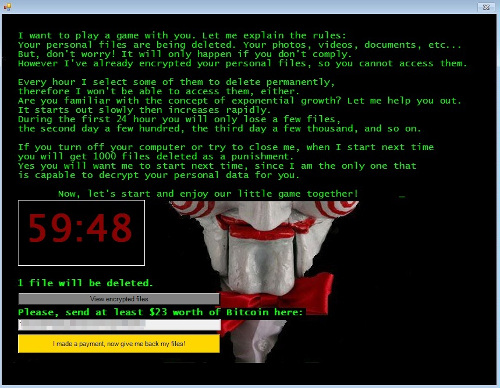RANSOM_JIGSAW.A
a variant of MSIL/Filecoder.Jigsaw.B trojan (ESET)
Windows


Threat Type: Trojan
Destructiveness: No
Encrypted: Yes
In the wild: Yes
OVERVIEW
Downloaded from the Internet, Dropped by other malware
This ransomware, discovered in April 2016, deletes the files it encrypts on a set time interval should the affected user delay payment. It also uses pornographic imagery in is routines. Users affected by this malware may have their personal information as well as important files/documents rendered useless via encryption.
To get a one-glance comprehensive view of the behavior of this Trojan, refer to the Threat Diagram shown below.

This Trojan arrives on a system as a file dropped by other malware or as a file downloaded unknowingly by users when visiting malicious sites.
TECHNICAL DETAILS
246,272 bytes
EXE
Yes
11 Apr 2016
Encrypts files, Displays message/message boxes
Arrival Details
This Trojan arrives on a system as a file dropped by other malware or as a file downloaded unknowingly by users when visiting malicious sites.
Installation
This Trojan drops the following copies of itself into the affected system and executes them:
- %Application Data%\Frfx\firefox.exe
- %AppDataLocal%\Drpbx\drpbx.exe
(Note: %Application Data% is the Application Data folder, where it usually is C:\Documents and Settings\{user name}\Application Data on Windows 2000, Windows Server 2003, and Windows XP (32- and 64-bit); C:\Users\{user name}\AppData\Roaming on Windows Vista (32- and 64-bit), Windows 7 (32- and 64-bit), Windows 8 (32- and 64-bit), Windows 8.1 (32- and 64-bit), Windows Server 2008, and Windows Server 2012.. %AppDataLocal% is the Application Data folder found in Local Settings, where it is usually C:\Documents and Settings\{user name}\Local Settings\Application Data on Windows 2000, Windows Server 2003, and Windows XP (32- and 64-bit); C:\Users\{user name}\AppData\Local on Windows Vista (32- and 64-bit), Windows 7 (32- and 64-bit), Windows 8 (32- and 64-bit), Windows 8.1 (32- and 64-bit), Windows Server 2008, and Windows Server 2012.)
It drops the following non-malicious files:
- %Application Data%\System32Work\Address.txt - bitcoin address
- %Application Data%\System32Work\EncryptedFileList.txt - list of encrypted files
- %Application Data%\System32Work\dr
(Note: %Application Data% is the Application Data folder, where it usually is C:\Documents and Settings\{user name}\Application Data on Windows 2000, Windows Server 2003, and Windows XP (32- and 64-bit); C:\Users\{user name}\AppData\Roaming on Windows Vista (32- and 64-bit), Windows 7 (32- and 64-bit), Windows 8 (32- and 64-bit), Windows 8.1 (32- and 64-bit), Windows Server 2008, and Windows Server 2012.)
It creates the following folders:
- %Application Data%\Frfx
- %AppDataLocal%\Drpbx
- %Application Data%\System32Work
(Note: %Application Data% is the Application Data folder, where it usually is C:\Documents and Settings\{user name}\Application Data on Windows 2000, Windows Server 2003, and Windows XP (32- and 64-bit); C:\Users\{user name}\AppData\Roaming on Windows Vista (32- and 64-bit), Windows 7 (32- and 64-bit), Windows 8 (32- and 64-bit), Windows 8.1 (32- and 64-bit), Windows Server 2008, and Windows Server 2012.. %AppDataLocal% is the Application Data folder found in Local Settings, where it is usually C:\Documents and Settings\{user name}\Local Settings\Application Data on Windows 2000, Windows Server 2003, and Windows XP (32- and 64-bit); C:\Users\{user name}\AppData\Local on Windows Vista (32- and 64-bit), Windows 7 (32- and 64-bit), Windows 8 (32- and 64-bit), Windows 8.1 (32- and 64-bit), Windows Server 2008, and Windows Server 2012.)
Autostart Technique
This Trojan adds the following registry entries to enable its automatic execution at every system startup:
HKEY_CURRENT_USER\Software\Microsoft\
Windows\CurrentVersion\Run
firefox.exe = "%Application Data%\Frfx\firefox.exe"
Other Details
This Trojan encrypts files with the following extensions:
- .jpg
- .jpeg
- .raw
- .tif
- .gif
- .png
- .bmp.accdb
- .db
- .dbf
- .mdb
- .pdb
- .sql.c
- .cpp
- .cs
- .h
- .php
- .asp
- .rb
- .java
- .jar
- .class
- .py
- .js.3dm
- .max.dwg
- .dxf.aaf
- .aep
- .aepx
- .plb
- .prel
- .prproj
- .aet
- .ppj
- .psd
- .indd
- .indl
- .indt
- .indb
- .inx
- .idml
- .pmd
- .xqx
- .xqx
- .ai
- .eps
- .ps
- .svg
- .swf
- .fla
- .as3
- .as.txt
- .doc
- .dot
- .docx
- .docm
- .dotx
- .dotm
- .docb
- .rtf
- .wpd
- .wps
- .msg
- .xls
- .xlt
- .xlm
- .xlsx
- .xlsm
- .xltx
- .xltm
- .xlsb
- .xla
- .xlam
- .xll
- .xlw
- .ppt
- .pot
- .pps
- .pptx
- .pptm
- .potx
- .potm
- .ppam
- .ppsx
- .ppsm
- .sldx
- .sldm.wav
- .mp3
- .aif
- .iff
- .m3u
- .m4u
- .mid
- .mpa
- .wma
- .ra
- .avi
- .mov
- .mp4
- .3gp
- .mpeg
- .3g2
- .asf
- .asx
- .flv
- .mpg
- .wmv
- .vob
- .m3u8.dat
- .csv
- .efx
- .sdf
- .vcf
- .xml
- .ses.Qbw
- .QBB
- .QBM
- .QBI
- .QBR
- .Cnt
- .Des
- .v30
- .Qbo
- .Ini
- .Lgb
- .Qwc
- .Qbp
- .Aif
- .Qba
- .Tlg
- .Qbx
- .Qby
- .1pa
- .Qpd
- .Txt
- .Set
- .Iif
- .Nd
- .Rtp
- .Tlg
- .Wav
- .Qsm
- .Qss
- .Qst
- .Fx0
- .Fx1
- .Mx0
- .FPx
- .Fxr
- .Fim
- .ptb
- .Ai
- .Pfb
- .Cgn
- .Vsd
- .Cdr
- .Cmx
- .Cpt
- .Csl
- .Cur
- .Des
- .Dsf
- .Ds4.Drw
- .Dwg.Eps
- .Ps
- .Prn
- .Gif
- .Pcd
- .Pct
- .Pcx
- .Plt
- .Rif
- .Svg
- .Swf
- .Tga
- .Tiff
- .Psp
- .Ttf
- .Wpd
- .Wpg
- .Wi
- .Raw
- .Wmf
- .Txt
- .Cal
- .Cpx
- .Shw
- .Clk
- .Cdx
- .Cdt
- .Fpx
- .Fmv
- .Img
- .Gem
- .Xcf
- .Pic
- .Mac
- .Met
- .PP4
- .Pp5
- .Ppf
- .Xls
- .Xlsx
- .Xlsm
- .Ppt
- .Nap
- .Pat
- .Ps
- .Prn
- .Sct
- .Vsd
- .wk3
- .wk4
- .XPM
- .zip
- .rar
It does the following:
- It deletes 1000 files when system is restarted by the user
- It deletes a file per hour when ransom amount is not yet paid
- It appends the extension .fun to the encrypted files
NOTES:
This ransomware displays a fake message:



SOLUTION
9.800
12.460.07
11 Apr 2016
12.461.00
12 Apr 2016
Step 1
Before doing any scans, Windows XP, Windows Vista, and Windows 7 users must disable System Restore to allow full scanning of their computers.
Step 2
Note that not all files, folders, and registry keys and entries are installed on your computer during this malware's/spyware's/grayware's execution. This may be due to incomplete installation or other operating system conditions. If you do not find the same files/folders/registry information, please proceed to the next step.
Step 3
Restart in Safe Mode
Step 4
Delete this registry value
Important: Editing the Windows Registry incorrectly can lead to irreversible system malfunction. Please do this step only if you know how or you can ask assistance from your system administrator. Else, check this Microsoft article first before modifying your computer's registry.
- In HKEY_CURRENT_USER\Software\Microsoft\Windows\CurrentVersion\Run
- firefox.exe = "%Application Data%\Frfx\firefox.exe"
- firefox.exe = "%Application Data%\Frfx\firefox.exe"
Step 5
Search and delete these folders
- %Application Data%\Frfx
- %Application Data%\System32Work
- %AppDataLocal%\Drpbx
Step 6
Restart in normal mode and scan your computer with your Trend Micro product for files detected as RANSOM_JIGSAW.A . If the detected files have already been cleaned, deleted, or quarantined by your Trend Micro product, no further step is required. You may opt to simply delete the quarantined files. Please check this Knowledge Base page for more information.
Step 7
Restore encrypted files from backup.
Did this description help? Tell us how we did.


